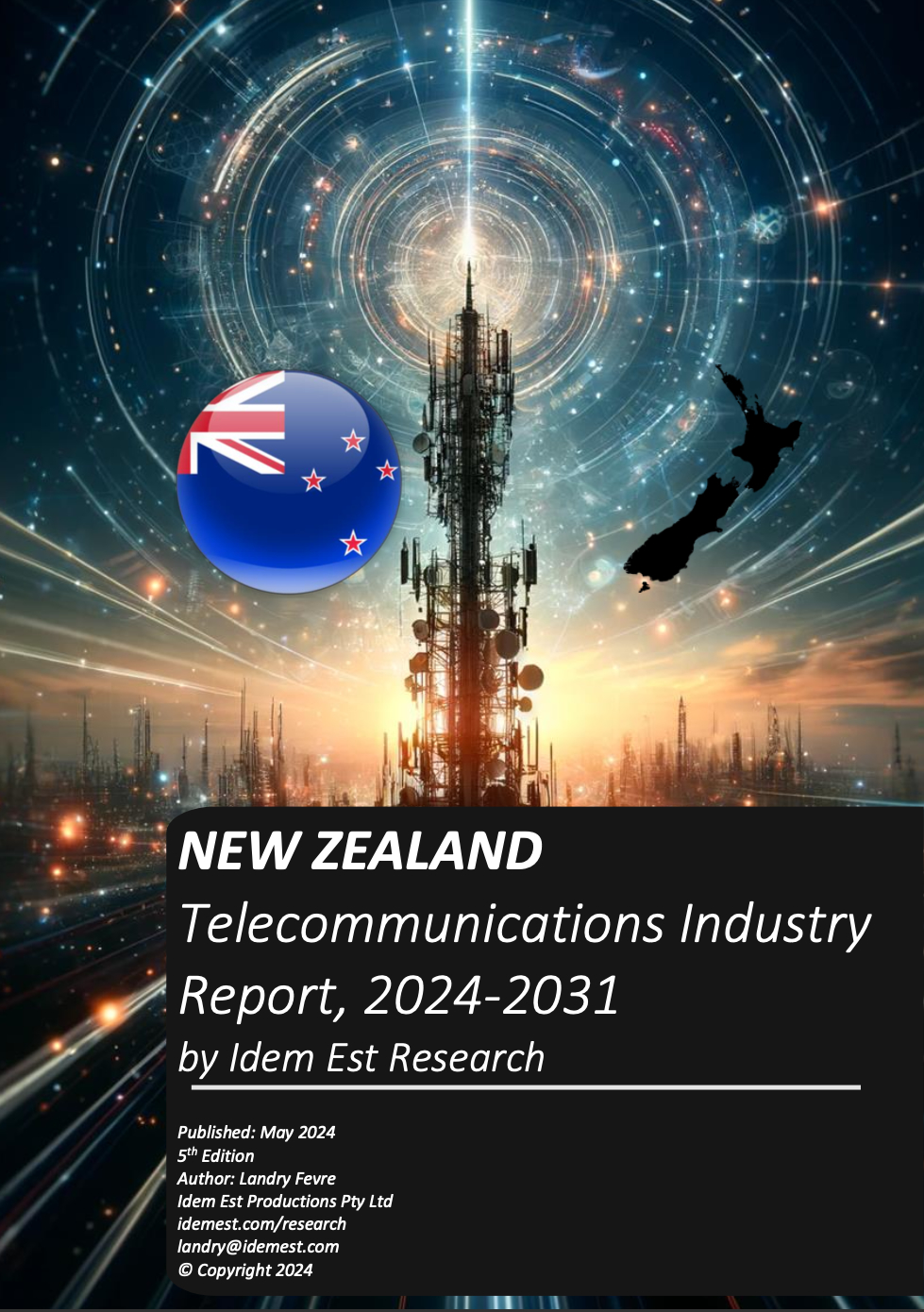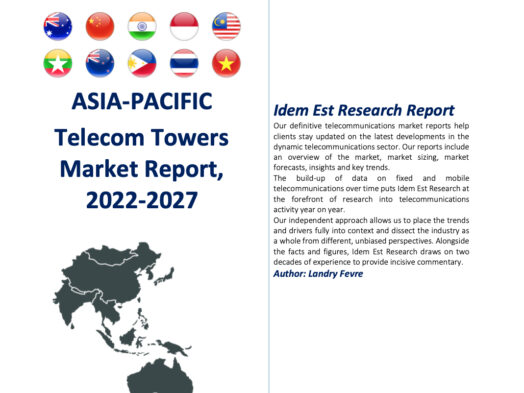Description
WHY YOU SHOULD BUY THE NEW ZEALAND TELECOMS INDUSTRY REPORT:
- Benefit from the latest market opportunities
- Understand the threats to your operations and investments and protect your company against future risks
- Gain insight on emerging trends that could support, strengthen or disrupt your activities in the market
- Get a full view of the competitive landscape to assess your market position.
- Forecasts as a key input for successful budgeting and strategic business planning in the telecoms market
- Target business opportunities and risks in the telecoms sector through our reviews of latest industry trends, regulatory changes and major deals, projects and investments
- Assess the activities, strategy and market position of your competitors, partners and clients via our Operators Profiles
The New Zealand Telecommunications Industry Report, 2024-2031 includes a comprehensive review of the New Zealand market dynamics, market sizing, market forecasts, analysis, insights and key trends.
EXECUTIVE SUMMARY
New Zealand Telecoms Industry Report at a Glance
The New Zealand telecommunications industry is a stable mobile market with 3 network operators, a nationwide full-fibre wholesale broadband network and the overall market underpinned by strong economic fundamentals.
Key developments covered in the New Zealand Telecoms Industry Report:
- Sale of towers of all three operators to pension funds
- Acquisition of My Republic by 2degrees
- Acquisition of Trustpower retail customer base by Mercury
- Divestments of passive tower infrastructure by both Spark and Vodafone underway
- UFB project completed and delivering word class broadband speeds nationwide
Idem Est Research forecasts that mobile subscriptions will continue to grow in the 2024-31 period and fixed broadband subscribers will also continue to grow and increase its household penetration over the same period. The ratio of the telecommunications sector revenue to GDP is declining from a peak in 2005, sliding down every year since then.
Idem Est Research forecasts 5G mobile subscribers will represent nearly 80% of all subscriptions by 2031, 4G will represent about 18% of all connections while 6G and 3G will account for the 2% remainder, while 2G and 3G networks will be switched off by 2025.
Mobile subscribers numbers and revenue are growing strongly and the back of population growth and the market shift to postpaid.
Idem Est Research expects the overall telecoms market to grow to NZD7.1 billion by to 2031 after a marked slow down in 2020 and 2021 due to legacy voice revenue pressure partially offset by mobile data growth and COVID travel restrictions.
Capex Investments
New Zealand is coming off a Capex hyper-cycle from a peak in 20219 down to NZD1.5 billion by 2022. The Capex to GDP ratio is now decreasing and is expected to remain at the same level through to 2031. Chorus is still investing heavily in fibre infrastructure until 2024 while Spark and Vodafone have more conservative investment profiles focusing mainly on 5G.
Mobile Subscribers and Revenue
Over the last five years, the market shifted to postpaid as subscribers move to Pay Monthly offerings (SIM-only plans) with increased data allowances. Overall, the number of prepaid subscribers continued to decrease slightly. Mobile network operators are facing competitive pressure with the market shifting to unlimited voice and text and data allowance increasingly becoming the sole offering differentiator.
According to our benchmark study of mobile data pricing, India has the lowest rate per GB at just a few cents per GB, while Australia and China had the biggest cost reduction per GB mostly due to increased data allowance in plans while Singapore remains expensive. New Zealand has the highest pricing per GB and Kiwis downloaded the least amount of data over their mobile phones.
Broadband Subscribers – FTTH Push and Fixed Wireless
The Ultra-Fast Broadband Initiative is a New Zealand Government program of building fibre-to-the-home networks covering 87% of the population by the end of 2022, FTTP is now deployed to 1.8 million households and businesses in 412 cities and towns. It is a public-private partnership of the government with four companies with a total government investment of NZ$2.1 billion.
The broadband market is now experiencing low growth mostly driven by new premises construction in greenfield developments or urban redevelopments. The UFB government project reached over 1.8m premises and connected 71% of them or 1.3m premises.
Households growth and a reduction of the number of underserved premises, previously not able to connect now served by UFB2, will drive up the fixed-broadband subscribers.
Thematics – Telecoms Infrastructure / 5G / M&A / Infrastructure
Infrastructure funds, pension funds and government funds are assigning high valuation multiples to telecommunications infrastructure assets such as mobile towers, data centres, submarine cable and fibre infrastructure.
In 2019, Morrisson & Co (Infratil) and Brookfield, both infrastructure funds, bought Vodafone NZ for NZ$3.4 billion (EV/EBITDA of .c7). Globally, many infrastructure funds are investing in mobile towers, FTTH, data centres, submarine cables while that trend is likely to continue over time with more proactive transactions. In 2023, Morrisson & Co (Infratil) purchased Brookfield’s stake to reach full ownership.
In 2022, 2Degrees and Orcon (Vocus NZ) merged to form the third largest telecommunications provider, it is co-owned by Macquarie and Aware.
In just 12 months, all three operators sold their respective towers to pension funds.
Idem Est Research predicts the next wave of transactions is likely to continue being about “scale” among small ISPs and largely about infrastructure for Spark, Vodafone and 2degrees.
The arrival of 4G moved the Internet off our desktops into our palms and pockets, 5G could transform the network from something we carry around to something taking us around either virtually (augmented reality or virtual reality) or in reality (autonomous vehicles), the 5G outcome and benefits beyond fast connectivity remain largely unknown in terms of business models, investments required and timeline.
KEY COMPANIES MENTIONED IN THIS REPORT:
2degrees, Brookfield, Crown Infrastructure Partner, Connexa, Crown Fibre Holding, Chorus, Enable Networks, Fourtysouth, Infratil, Mercury, Northpower, One NZ, Telecom NZ, Snap, Spark, TelstraClear, Trustpower, Tuatahi First Fibre, Ultra-Fast Fibre, Vocus, Vodafone, WEL Networks.
New Zealand Telecoms Industry Report – Table of Contents
1 Key Statistics
1.1 New Zealand’s Population
1.2 New Zealand’s Economy
1.3 New Zealand’s GDP
2 Overall Telecommunications Market, 2017–2031
2.1 Market Overview
2.2 Historical Telecommunications Market Revenue, 2017-2023
2.3 Overall Telecommunications Market Forecast, 2023-2031
2.4 Telecommunications Market Capital Expenditure, 2017-2031
2.4.1 Historical Telecommunications Capex Spend, 2017-2023
2.4.2 Capex to Revenue Benchmark
2.4.3 Capex to GDP Benchmark
2.4.4 Telecommunications Capex Spend Forecast, 2023-2031
3 Telecommunications Operators Profile
3.1 Spark New Zealand Profile
3.1.1 Spark Revenue EBITDA and Capex Mix
3.2 One New Zealand Profile
3.2.1 One NZ Revenue EBITDA and Capex Mix
3.3 2Degrees
3.3.1 2degrees Revenue EBITDA and Capex Mix
3.3.2 Vocus New Zealand (Historical) – Archived
3.4 Chorus Profile
3.4.1 Chorus Revenue, EBITDA & Capex Mix
3.5 Other Players Profile
3.5.1 Mercury
4 Mobile Market
4.1 New Zealand Mobile Subscribers Historical and Forecast, 2017-2031
4.1.1 New Zealand Mobile Subscribers Historical, 2017-2023
4.1.2 New Zealand Mobile Subscribers Market Share, 2017-2023
4.1.3 New Zealand Smartphone Share, 2024
4.1.4 New Zealand Mobile Subscribers Forecast, 2023-2031
4.1.5 New Zealand Mobile Subscribers by Generation (2G, 3G, 4G & 5G) Forecast, 2023-2031
4.2 New Zealand Mobile Revenue Historical and Forecast, 2017-2031
4.2.1 Historical Mobile Revenue, 2017-2023
4.2.1 New Zealand Mobile Revenue Market Share, 2017-2023
4.2.2 Mobile Subscribers ARPU, 2017-2023
4.2.3 New Zealand Mobile Revenue Forecast, 2023–2031
4.3 Mobile Coverage
4.4 Spectrum Holdings
4.4.1 Historical of Spectrum Auctions and Costs
4.4.2 5G Spectrum Allocations
4.4.3 Mobile Frequencies Portfolios Analysis
4.4.1 Spectrum Depth Benchmark by Country
4.5 Mobile Download Data and Pricing Trends
4.6 Mobile Speed Tests
4.7 Internet of Things (IoT)
5 Broadband Market
5.1 New Zealand Fixed Broadband Subscribers Historical, 2017-2023
5.2 New Zealand Fixed Broadband Subscribers Forecast, 2023-2031
6 Satellite Internet Connectivity
6.1 Comparing LEO, MEO, and GEO Satellite Orbits
6.1.1 LEO and GEO Satellite Comparison
6.2 Satellite Broadband Providers Operators, 2023
6.3 5G NTN: The Next Generation of Satellite Connectivity
6.3.1 5G NTN Overview
6.3.2 The Rationale Behind 5G NTN
6.3.3 Technical Aspects of 5G NTN
6.3.4 Potential Applications for 5G NTN
6.3.5 Challenges in Implementation
6.3.6 5G NTN Satellite Providers
6.4 Satellite Internet Market Analysis, 2023-2031
6.4.1 Market Landscape of Satellite Broadband Subscribers, 2023
6.5 New Zealand Satellite Broadband Subscribers Forecast, 2023-2031
7 Fixed Telecommunications Infrastructure Investments
7.1 Fixed Digital Infrastructure
7.1.1 The Ultra-Fast Broadband (UFB)
7.1.2 Submarine Cables
8 New Zealand Telecom Towers Infrastructure Landscape
8.1 Small Tightly Held Tower Market
8.1.1 New Zealand Telecom Towers Background
8.2 New Zealand Telecom Towers Market Forecast
8.2.1 New Zealand Telecom Towers Forecast, 2023-2031
8.2.2 Regulatory Considerations
8.3 Tower Density Benchmark
8.4 Telco Infrastructure Comparative
9 Thematics / Opportunities
9.1 Consolidation Opportunities
9.2 Diversification Opportunities
9.3 New Telecoms Operating Model
9.3.1 The Attraction of Infrastructure Multiples
9.4 6G Developments
10 Telco Transaction Database
11 Methodology
12 Copyright Notice
New Zealand – Telecoms Industry Report – List of Figures
Figure 1 – Telco sector revenue as % of GDP in New Zealand
Figure 2 –Revenue Profile Historical Mix (NZD million), 2017 – 2023
Figure 3 –EBITDA Profile Historical Mix (NZD million), 2017 – 2023
Figure 4 – Telecommunications Market Revenue, 2023
Figure 5 – Telecommunications Market EBITDA, 2023
Figure 6 – Telecommunications Revenue & EBITDA Share, 2023
Figure 7 – Total Telecoms Market Revenue and Growth Rate (NZD bn), 2023-2031
Figure 8 – Capex to Revenue Benchmark, 2017-2023
Figure 9 – Capex to GDP Ratio Benchmark, 2016-2022
Figure 10 – Telecommunications Capital & Operational Expenditure Spend, 2000-2031
Figure 11 – Spark Service Revenue Mix, 2017-2023
Figure 12 – Spark Historical Revenue Mix, 2017 – 2023 (NZD million)
Figure 13 – One NZ Revenue Mix, 2017-2023
Figure 14 – One NZ Historical Revenue Mix, 2017 – 2023 (NZD million)
Figure 15 – 2degrees Revenue and EBITDA, 2017-2023 (NZD million)
Figure 16 – Chorus Service Revenue Mix, 2017-2023
Figure 17 – Chorus Historical Revenue Mix, 2017 – 2023 (NZD million)
Figure 18 – New Zealand Mobile Subscribers Share Comparison, 2017-2023
Figure 19 – New Zealand Mobile Subscriber Share Comparison, 2017-2023
Figure 20 – Mobile Net Adds (000’s) Comparison, 2017-2023
Figure 21 – New Zealand Mobile Subscribers Forecast, 2023-2031
Figure 22 – Mobile Subscribers by Generation Forecast, 2022-2030
Figure 23 – New Zealand Mobile Revenue Share Comparison, 2017-2023
Figure 24 – Mobile Subscribers ARPU (NZD), 2017-2031
Figure 25 – New Zealand Mobile Revenue Forecast, 2023-2031
Figure 26 – Subscriptions per MHz of Spectrum, Select Asia-Pacific Countries, 2024
Figure 27 –Mobile Handsets Monthly Download Data, 2017-2023
Figure 28 – Data Pricing Trends in Asia-Pacific (USD per GB per month), 2017-2023
Figure 29 – Asia Pacific Data Pricing Benchmark, 2023
Figure 30 – Spectrum available for IoT in New Zealand
Figure 31 – New Zealand Broadband Subscribers Share Comparison, 2017-2023
Figure 32 – New Zealand Net-Adds (000’s) by Operators, 2017-2023
Figure 33 – UFB Services by Speed
Figure 34 – New Zealand Broadband Subscribers Forecast, 2023-2031
Figure 35 – Satellite Deployments Type
Figure 36 –Starlink and OneWeb Satellite Launches per Month (Data until Jan-24)
Figure 37 –New Zealand Satellite Broadband Market Share, 2023
Figure 38 – New Zealand Satellite Broadband Subscribers (k) Forecast, 2023-2031
Figure 39 – New Zealand Tower Market Share, 2023
Figure 40 – New Zealand Telecom Towers Forecast, 2023-2031
Figure 41 – Capita per Tower, 2024
Figure 42 – Telecoms Providers’ EV/EBITDA Ranges
New Zealand Telecoms Industry Report – List of Tables
Table 1 – New Zealand – Key Statistics
Table 2 – Telecommunications Market Revenue by Operators
Table 3 – Total Telecommunications Market Revenue, 2023-2031
Table 4 – Historical Telecommunications Capex Spend, 2017-2023
Table 5 – Total Capex Spending Market Revenue, 2023-2031
Table 6 – Historical Spark Service Revenue, EBITDA & Capex, 2017-2023
Table 7 – One NZ Service Revenue and EBITDA Mix, 2017-2023
Table 8 – 2degrees Service Revenue and EBITDA Mix, 2017-2023
Table 9 – Historical Vocus Service Revenue, EBITDA & Capex, 2015-2021
Table 10 – Chorus Wholesale UFB Pricing and Speeds
Table 11 – Historical Chorus Service Revenue, EBITDA & Capex, 2017-2023
Table 12 – New Zealand Historical Mobile Subscribers, 2017-2023
Table 13 – New Zealand Mobile Subscribers Forecast, 2023-2031
Table 14 – New Zealand Mobile Subscribers by Generation (2G, 3G, 4G, 5G & 6G) Forecast, 2023-2031
Table 15 – Historical Mobile Service Revenue, 2017-2023
Table 16 – Historical Mobile ARPU, 2017-2023
Table 17 – New Zealand Mobile Service Revenue Forecast, 2023-2031
Table 18 – Historical Spectrum Auctions and Costs (NZD)
Table 19 – Mobile Frequencies by Operators and by Band (MHz)
Table 20 – Historical Broadband Subscribers, 2017-2023
Table 21 – Historical Broadband Monthly ARPU, 2017-2023
Table 22 – New Zealand Broadband Subscribers Forecast, 2023-2031
Table 23 – Satellite Orbit Altitudes
Table 24 – LEO and GEO Satellite Comparison
Table 25 – Satellite Broadband Subscribers Operators, 2023
Table 26 – 5G NTN and Satellite Providers, 2023
Table 27 – New Zealand Satellite Broadband Subscribers Forecast, 2023-2031
Table 28 – International Submarine Cable Systems with Landing Stations in New Zealand
Table 29 – New Zealand Telecom Towers Market Analysis, 2023
Table 30 – New Zealand Telecom Towers Indicative Tower Leasing Annual Fees
Table 31 – New Zealand Telecom Towers and Rooftops, Tower per Capita, 2023-2031
Table 32 – Spark, Vodafone, Vocus and Chorus Telco Infrastructure Landscape
Table 33 – Telco Transaction Database, 2001-2023
Other Idem Est Research Telecoms Country Reports
Australia, Bangladesh, China, India, Indonesia, Japan, New Zealand, Malaysia, Myanmar, Pakistan, Philippines, Singapore, South Korea, Taiwan, Thailand, Vietnam,
Asia Pacific Telecom Towers, Asia Pacific Satellite Internet, Starlink Company Profile






